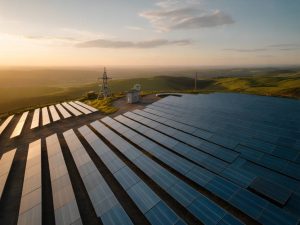The Rise of Community Solar Farms: A Game Changer for Local Economies
When we think about renewable energy, our minds often conjure images of towering wind turbines or expansive solar parks stretching across the horizon. But there’s an unsung hero in the renewable energy landscape: community solar farms. These localized solar projects are more than just an environmentally friendly energy source; they’re economic engines for the communities they serve. So, how exactly do community solar farms impact local economies, and why should we all be paying attention?
What Are Community Solar Farms?
Before we dive into their economic impact, let’s define what community solar farms are. A community solar farm is a shared solar energy project where multiple participants, such as homeowners, renters, or businesses, subscribe to a portion of the clean energy produced. Unlike traditional solar installations that require rooftop space, community solar programs allow people to benefit from solar power without the need for their own panels. Think of it as a local cooperative where the sun is the shared asset, and everyone profits.
By pooling resources, these solar farms overcome barriers like high upfront costs and unsuitable rooftops, making solar energy more accessible to the average person. But their benefits go way beyond the environmental; they’re turning out to be a financial boon for local economies.
Job Creation: Local Opportunities Abound
Building and maintaining community solar farms create jobs. From the initial stages of planning and installation to ongoing maintenance, there are roles for local electricians, engineers, project managers, and even marketing professionals. According to the National Renewable Energy Laboratory (NREL), the solar industry employs over 250,000 Americans—and community solar projects are a growing slice of that pie.
For example, when a small town in Colorado launched its first community solar farm, over 50 local jobs were created during the construction phase alone. Beyond construction, ongoing maintenance and administration also generate long-term employment opportunities. And because these jobs are inherently local, the money stays within the community rather than being funneled back to large, centralized corporations.
Keeping Energy Dollars Local
Traditional energy production often involves outsourcing—whether it’s importing fossil fuels or relying on large, national grid systems. Community solar flips the script by keeping energy dollars local. When residents subscribe to a solar project, the payments they make often go back to local cooperatives or businesses managing the solar farm. That revenue contributes to the local economy, funding schools, infrastructure, and other community needs.
Consider a small rural town that previously relied on an out-of-state utility company. After launching a community solar project, the town not only reduced its carbon footprint but also kept millions of dollars circulating in its local economy. Local businesses saw increased spending, and municipal budgets were boosted. It’s a win-win.
Cost Savings for Residents and Businesses
One of the most tangible ways community solar impacts local economies is through cost savings. Subscribers to these programs often see reduced utility bills without the financial burden of installing and maintaining their own solar panels. Lower energy costs mean residents have more disposable income to spend at local businesses, fueling economic growth in their communities.
For example, a bakery owner in upstate New York estimated that participating in a community solar project saved her over $2,000 annually on energy costs. She redirected those savings into upgrading her equipment and hiring another employee—a direct, positive impact on her local economy.
Energy Independence: Building Resilience
Another often-overlooked benefit of community solar farms is their contribution to energy independence. With locally-generated energy, communities become less reliant on external energy sources, which can be especially crucial during emergencies or natural disasters. This resilience translates into economic stability, as local businesses and essential services can continue operating when the centralized grid goes down.
Take Puerto Rico, for instance. After Hurricane Maria devastated its centralized power grid, the island began investing in community solar projects as a way to rebuild more resiliently. Local communities now enjoy more stable energy prices and a sense of security knowing they’re less dependent on external resources.
Attracting New Investments
Communities with thriving community solar programs also tend to attract outside investment. Solar farms signal to potential investors and companies that the area values sustainability and innovation—characteristics that are increasingly important in today’s market.
For example, a county in Minnesota saw its real estate market experience a small boom after launching several community solar projects. The clean, affordable energy attracted tech companies, eco-conscious startups, and families looking to settle in a progressive, green-minded area. These new residents and businesses brought more tax revenue and economic dynamism to the region.
Fostering a Sense of Community Ownership
There’s an intangible yet incredibly powerful economic benefit to community solar farms: the sense of pride and ownership they instill. When locals feel they have a stake in their energy production, they’re more likely to engage in other community projects, shop locally, and invest their time and resources into improving their surroundings.
A survey from a community solar project in Oregon found that 85% of participants reported feeling more connected to their neighbors and local businesses after joining. This sense of cohesion often translates into a stronger, more resilient local economy as residents and businesses collaborate on other initiatives.
The Ripple Effect: Expanding Beyond Energy
The economic benefits of community solar don’t stop with energy generation or cost savings. They create a ripple effect that touches nearly every sector of a community. From supporting local schools and infrastructure projects through increased tax revenue to inspiring other sustainability initiatives like community gardens or green building practices, the positive impacts are far-reaching.
For instance, a town in Vermont used proceeds from its community solar farm to fund scholarships for local students pursuing careers in renewable energy and sustainability. This kind of reinvestment not only strengthens the local economy today but also builds a pipeline of skilled workers for the future.
What’s Next for Community Solar?
As more towns and cities recognize the multifaceted benefits of community solar farms, we’re likely to see a surge in their adoption. Policies and incentives, such as tax credits and grant programs, are being rolled out to encourage both individuals and municipalities to embrace this model. If anything, the question is no longer “Why should we invest in community solar?” but rather, “Why aren’t we doing this already?”
The beauty of community solar is that it democratizes renewable energy. It’s not just about reducing carbon emissions or flipping a switch on a solar panel; it’s about economic empowerment, community resilience, and building a brighter future for everyone. The sun doesn’t discriminate, and neither should access to its abundant energy—and the economic possibilities it offers.






More Stories
L’essor des communautés énergétiques locales : vers une nouvelle gouvernance citoyenne de l’énergie
Powering Data Centers Sustainably: The Role of Renewable Energy in the Digital Age
Integrating Biophilic Design with Green Technology: A New Paradigm for Sustainable Living